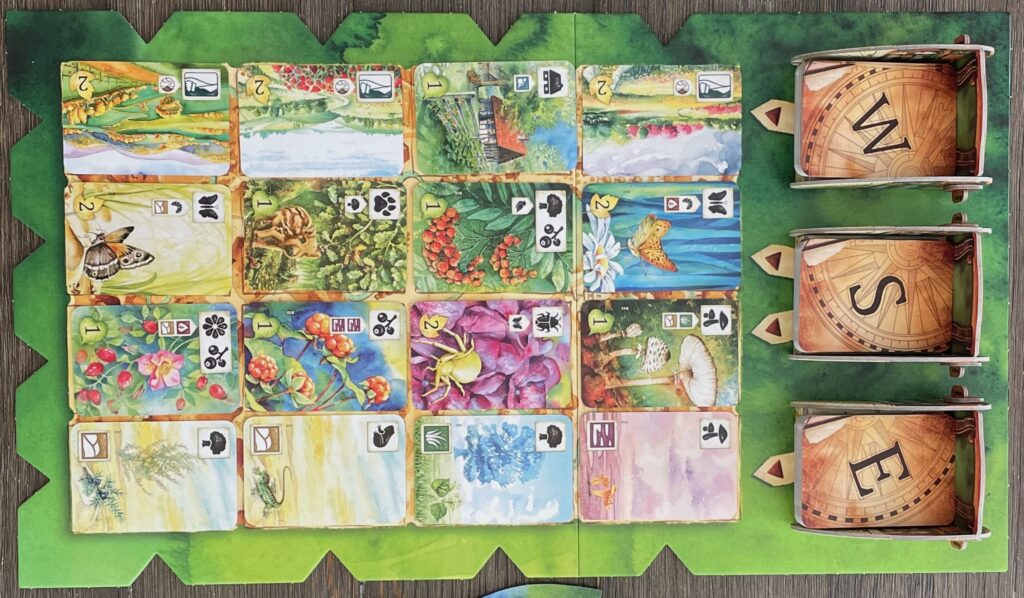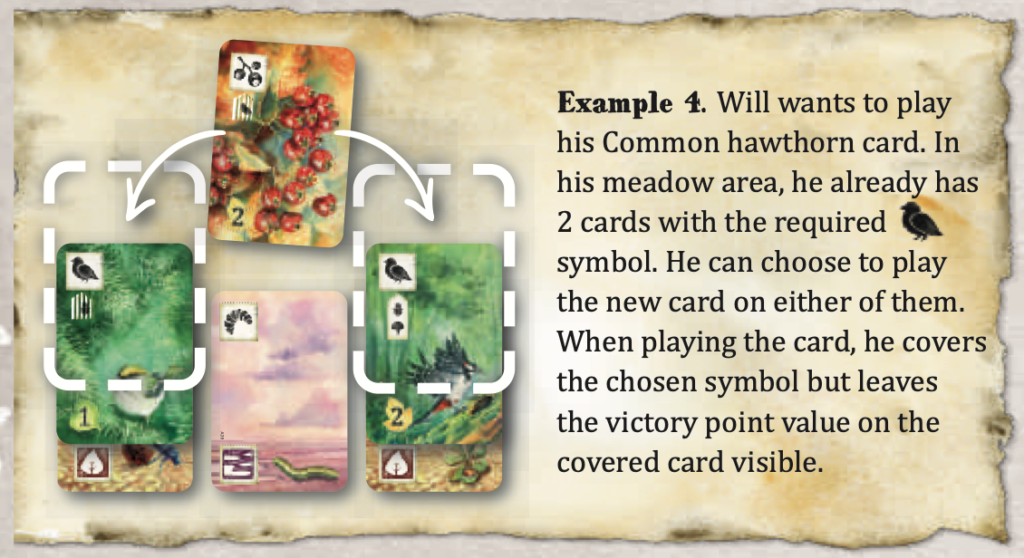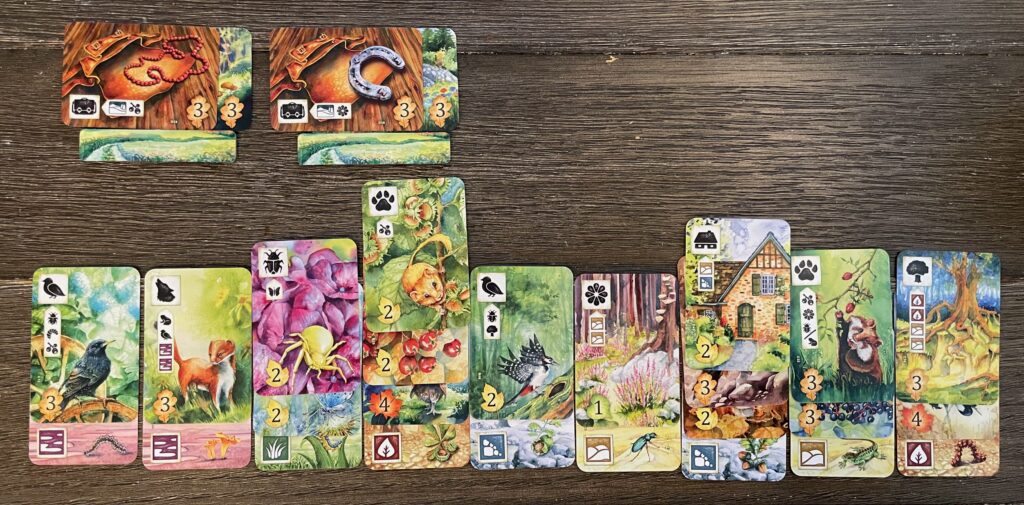I’m not sure why, but I initially thought Meadow was not a board game our family would enjoy. I was under the impression that it was complex and had asymmetric player powers, which both turned out to be false. In reality, this is a beautiful game designed by Klemens Kalicki and published by Rebel Studio. It’s easy to teach and it makes you think.
What’s it all about?
In a game of Meadow, your goal is to wander around nature and observe your surroundings. As you do this, you’ll collect these observations (cards) and add them into your own personal meadow filled with animals, plants, and landscapes!
Main board, campfire, and path tokens
Before we get into gameplay, let’s take a look at a few essential components:
Main Board
This is the location where available cards are laid out in a tableau for players to draft. There are decks of cards at the top of each column that refresh the cards below. The main board has triangular notches all around the card area, which is where players will place their path tokens during their draw card action.

Campfire
The campfire board is where players can take special actions during their turn. These special actions include:
- Selecting any single card from the main board
- Drawing 3 cards from a single card deck, add one to your hand
- Play 2 cards into your own meadow
- Gain 2 road tokens
Path Tokens
Players will use path tokens to select their actions during a turn. Every path token can be used on either the main board or campfire board. Each path token has 2 actions. The top action is used on the main board, and the bottom action is used on the campfire board.
- Meadow actions will indicate which card you can draw from the main board.
- Campfire actions will give you the special abilities noted above
How does it play?
Gameplay takes place over 6 rounds, and each round has 5 turns per player*. At the start of a round, each player takes the 5 path tokens of their color. Going in clockwise rotation, players will take turns placing their path tokens in either the meadow or campfire boards, and then resolving their actions.
After the first three rounds, when the round marker passes over the hourglass, you’ll prepare the meadow for the second half of the game. The South deck is replaced with the North deck. All cards in the meadow are refreshed with new cards from the decks.
*In a 4 player game, there are 8 rounds with 4 turns per player! This gives players an equal number of opportunities to be the starting player.
Building your Meadow
Every card you play into your meadow has 2 symbols: A card symbol and a ground symbol. You will build your meadow in columns, with the base of each column begin a ground symbol. The card symbol represents a requirement. New cards that you want to play into your meadow will need to have the same requirement.

Each player can have up to 10 ground cards in their meadow. The more columns you establish in your meadow, the more card symbols you’ll be able to display. As the game advances, the cards you’ll draft have multiple card symbol requirements. It’s important to be aware of what you need, what you’re covering up, and what you’ve got available.
You’ll continue to add cards into your meadow through the duration of the game. All cards (with the exception of the ground cards) are worth victory points. At the end of the game, players will add up the victory points on their cards, and any bonus points scored. Highest point total wins the game!
A note about selecting cards from the main board
How you choose your card from the main board is an important piece of strategy in this game. Because each path token has actions for both the main board and the campfire board, and they can each be used once per round, you’ll have to carefully consider when and how to use each one. If you know you need more road tokens from the campfire board, you’ll need to make sure you don’t use the path token that grants that ability to draft a card on the main board instead!
Solo
Meadow includes a solo mode, which is easy to implement. You’ll use a small solo board and the path tokens of the remaining 3 colors to remove a card from the meadow each turn. This simulates a 2 player game well. The rest of the game plays like normal. For scoring, you’ll add up your victory points, and compare them with the victory points of the cards that your opponent (Rover) collected. If you outscore Rover, you win!
What do we think?
Overall, we’ve had a lot of fun with Meadow. I’m happy we were finally able to add a copy to our collection, and I think it will continue to be enjoyable for many years to come. Let’s take a look at a few points worth mentioning:
Pros:
- The components for Meadow are fantastic. I love the little deck trays you build. Once assembled, the trays (and their corresponding cards) fit neatly into the box insert!
- Game setup is quick. Having the cards already in the deck trays decreases the amount of time you’d spend fiddling around with components.
- The rulebook is a bit long, but the game itself is pretty easy to teach. We’ve been able to explain a few basic rules and then dive into play.
- Excellent solo mode
- I like the way you have to choose which action to use on every path token.
- I love the puzzly/thinky nature of Meadow. It reminds me a lot of Calico, but with a less frustrating ending!
- There’s a companion guide that lists each card and provides a bit of info about what they are. My daughter loves this, and I think it’s cool she’s learning something while we play!
Cons:
- Due to the thinky/puzzly nature of Meadow, analysis paralysis is real with this game. I find AP worse in the beginning of the game when you’re trying to figure out the best path forward, but at any point in the game you you can find yourself stuck without a great move to make. And then you just stare desperately at the cards.
- Certain symbols, like the house and the fence, can be difficult to get. If you have an opportunity to claim one, it’s probably not a bad idea to do so! *There’s a helpful reference on the back of the rulebook that breaks down the distribution of each symbol in the game.
- Game can be a bit fiddly. Having to stop and reset the main board at the halfway point can be annoying, but it’s also nice to have new cards to look at.
- The age rating is 10+, and the game is very teachable, but not all kids are going to love this one. My 10 year old, who loves puzzles and nature, also loves this game. My 9 year old won’t come near it!





